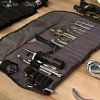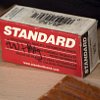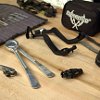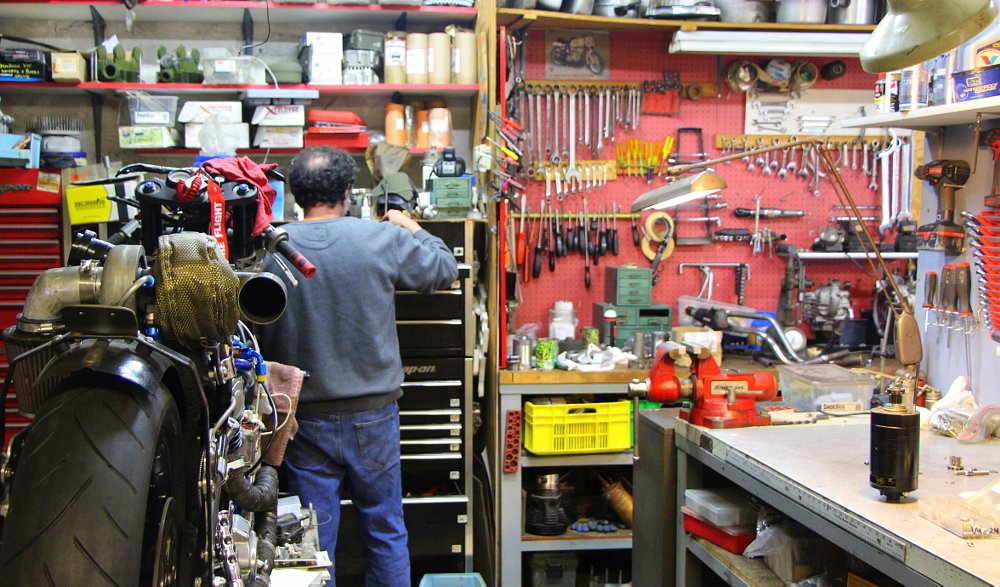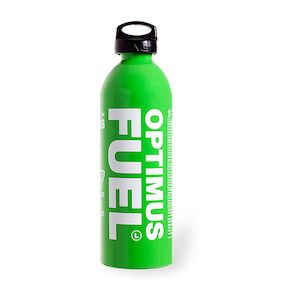“What do I need in my tool kit?”
Depends what you break and what you know how to fix, really. I think most people can dial in a decent tool kit for themselves pretty easily. I’ll talk about some theory, and work some personal anecdotes in, and hopefully I can get your brain workin’ on some things you might not have considered. We'll start with some general ideas, then move into a few specific tips I have for you. And why should you trust me? Because I ride old junk that never seems to get very far without a breakdown, and all my buddies are in the same boat. We're breakdown experts.
Mindset
This should be your first assessment. How do you feel about a breakdown? Nervous? Anxious? Does it give you crippling fear or is it a minor inconvenience? (Believe it or not, some people enjoy on-the-road fixes. I kind of like them, at times.) Are you willing to fix something on the side of the road?
If being broken down stresses you out, a cell phone and a full wallet are all the tool kit you need on American pavement. There’s no shame in that game. If you don’t want to fix your bike, don’t. Carry a phone, cash, credit cards, and a portable battery charger.

Skillset
Assuming you want to take on on-the-road repairs, let’s talk about your skill level. The tools you select should be ones you can use confidently. If you don’t know what a DVOM is or does, carrying one in your toolkit won’t be real helpful. (Unless, of course, you break down with a buddy who knows how to diagnose electrical issues and you happen to have that type of problem.)
If you have no idea how to change a tire, you’re at a crossroads. It’s either time to learn how before you break down, or you probably shouldn’t carry tire repair tools. I’m not suggesting every rider needs to become a pro wrench, but packing heavy on tools you can’t use is a waste of space.
If you don’t wrench regularly, perform some maintenance tasks at home with the same tools you intend to carry on the road. Way back when, I needed to adjust my idle on an inline-four-cylinder bike I was riding. I was anxious to get on the road and figured I’d just do it when I pulled over at a fuel stop. That little idle screw, though, required a flathead screwdriver — that was about a foot long! I had a flathead in my tool roll, but not one of that length. I wound up using electrical tape to fasten it to a wrench. If you’re not a fan of doing your best MacGyver impersonation when your bike is in need of attention, you can save yourself some headaches. By using the tools in the shop that you intend to have on hand when you break down, you can make sure your tool roll is tailored to your machine. It’s not just about being able to do the job, it’s being able to do the job in adverse conditions with the tools at hand. (You may now insert requisite joke about the length of my tool.)
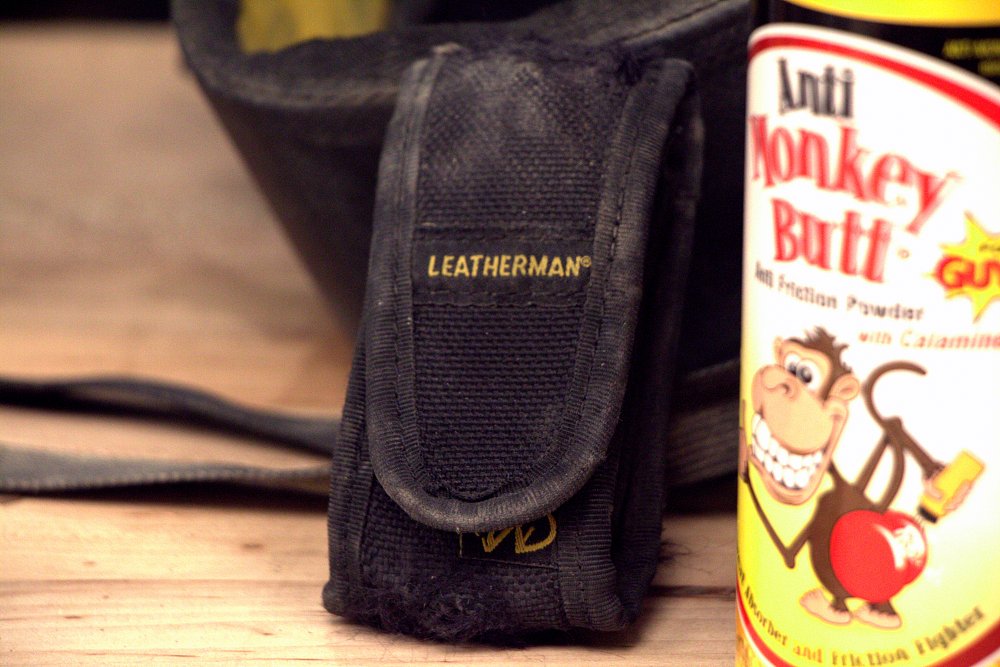
Toolset
If you feel like making repairs on the move fits with your mindset and skillset, then it's now time to choose your tool kit! I have some definite thoughts on what is good for me, but the reality is there is absolutely no way for me to tell you what’s good for you. I can give you a few specific things to ponder before assembling that tool roll, however.
How are you moving the tools? I am more apt to take a lot of breakdown stuff when I’m on a short ride on a bike with big bags. On the opposite end of that spectrum, if you are riding off-road and camping, space is at a huge premium, so every piece has to be carefully considered. Are you going to have a chase vehicle or tow rig? I bring a bunch of tools when I go to race — because they are in my truck!
Also consider the vessel itself. What will schlep your stuff? A tool roll? Tail bag? Tank bag? One whole saddlebag?! I’d probably choose the container after I determined the tools I was bringing if I had one bike, but packing your tools in separate kits can make bouncing from one bike to another easier. That said, it can be cheaper to have one kit if that works for the bikes you ride.
Personally, I have three major “containers” if riding a modern motorcycle. One includes all my tire-repair gear for both tube-type and tubeless tires, as well as universal items… a tire pressure gauge, some lip balm, a few knock-off Crampbusters, 90-degree valve adapters, and a coupla parky pucks or junction box covers. One contains either metric or SAE tools and appropriate parts, depending on what I'm riding. The third involves fluids. I always have a bottle of go-juice, and I often bring oil for my older, leakier machinery or my two-stroke junk. Spurg tends to go far on his bikes and they’re all chain-driven (but don’t blow oil all over the final-drive chain like my old piglets). I know I’ll see him toss a bottle of chain wax into a saddlebag when we’re packing to go somewhere. (I usually bring some stop-juice for us, too… nothing beats a little whiskey after a day’s worth of mileage. Gotta keep your mechanic properly lubricated.)

What are you riding? New sport bike? Vintage Brit bike? Late-model Bavarian ADV? All of those bikes are going to need different tools. Part of that has to do with the type of fasteners used. (Metric? SAE? Whitworth? External Torx? A combination?) Part of it also has to do with how the bikes are used (and will break.) An two-stroke, off-road trail-runner is going to have broken parts from crashes and quite a few fouled spark plugs. On the other hand, a rider on an old vintage machine probably will spend a fair amount of time snugging fasteners and reattaching parts that shook off the machine. Their tool rolls should reflect those differences.
Similarly, tire plugs don’t do you a hell of a lot of good if you have tube-type tires, and an inflator that doesn’t clear a big brake rotor is either going to be useless or make a lot more work for you if you’re on the side of the road. This sort of dovetails with the earlier point I made about completing the job in the shop in a practice scenario. Not only do you need to know how to use the tools, but you also need to know the tools are the right ones for the job. For most riders, this will mean carrying some general tools and some specific ones.
This means if you are riding multiple bikes or disciplines, you may want to think about having multiple setups — it might keep your tool roll from approaching the size of a bedroll.

Bought or built? Some people like the ease of starting with a pre-built tool kit. Others want to pick and choose, building from scratch. I think either is acceptable, but if you start with a pre-built kit, you may notice you’re getting lower quality tools relative to the cost because you’re paying for convenience. You can probably score nicer tools for less money if you assemble a set for yourself. Also, expect to remove a few tools and add a few — think of the pre-assembled kits as a good jumping-off point.
If you build your own kit, I’d actually encourage you to opt for cheap tools. They’re going to be in the weather, out on the road, borrowed, lost, left behind, and occasionally they'll just plain fall off. It’s a hell of a lot easier to kiss a Pittsburgh wrench goodbye than a Matco. The local flea market might be just the ticket.
No matter what route you take, don’t forget about factory tools. Some bikes still come with a factory tool kit. (You might need to purchase it, but it still may exist.) Often, the tools in here are cheap (but adequate), so plunder that first. Second, those tools are frequently just what the doctor ordered in spite of their lack of ruggedness. Way back when, thin-wall sockets often came in OEM tool kits. That cheap thing made of recycled washing machines very well might work better than the fancy MAC piece that costs 12 times as much but doesn't fit into the tight spaces of your bike's engine. The difference is that one of those tools was made specifically for your make and model of motorcycle.
Whatever approach you take, you will probably need to pack some tools that are specific to your bike. In my “old Harley” kit, I carry a huge 7/16-inch hex wrench. It’s used to access the lug nuts which hold the drum to the wheel — I like to check their snugness very regularly, but this tool is more or less useless on any other motorcycle. If you own a late-model adventure bike, you’re going to need a hollow axle tool to change tires. Modern Harley riders, without a T27 torx driver or bit in your pack, you’re going to have a hard time with even the most basic tasks — that’s not a size that comes in common sets. No matter your bike, there are sure to be tools specific to it you’ll want to bring along.

Let’s not also forget about making tools. I do this a lot. Some I make for convenience. I cut down larger hex keys so they fit into my pack. Same deal with my axle nut wrench. Some others I make to make my life easier. For instance, my good buddy Hutch has a tool he came up with and I copied. It’s a spark plug socket he cut down a little and welded to a handle. It is short enough that it doesn’t interfere with overhanging Fat Bob tanks. Without that very specific tool, changing plugs on the side of the road can become a minor pain in the ass. I also carry a small tube that I can fit over other tools to get more leverage, so cutting things down isn't a problem.
Bring stuff you don’t need, I am contradicting myself, but there are some things that other, less prepared riders may have a use for that might make your breakdown stop shorter. For instance, I carry tire plugs, even though all my personal bikes use tubes. I’ve repaired the tires of many a fellow rider. (And I do find myself on some test bikes that have alloy wheels.) Spurg does something similar — he rides dual-sport events with so many people on the ubiquitous BMW R 1200 GS that he carries the Torx drivers required to remove the wheels on those bikes.

Don’t forget about parts. Whether it’s bulbs, a spare primary belt, or an extra cable or two, some parts break a lot on some bikes, and having extras can be the difference between a long gas stop and a long wait for a tow truck.
And make sure they’re the right parts. For instance, you might want to carry fuses. Do you know what you have protecting your wiring? Glass? Mini fuses? Micro? Low-pro micro? Standard ATC blade-type? Check to make sure you’re getting the right ones before you buy (or leave)!
And don't forget fasteners, either. Even just some generic hardware can save the day in many situations. Make sure you've got the right stuff, too. I have some hardware in my dirt tool roll — you better believe it’s all metric. If you have a Harley, it’s gonna be SAE, and for those of you on old British machinery, there’s a good chance you’ll need some Whitworth bits.
Nor should you forget about nonstandard fasteners. Zip ties, safety wire, duct tape, straps, and rope all have their places, and one of those places should be in your tool roll. I also carry a tube of threadlocker. I keep a set of RokStraps in my kit, too… I’m notorious for coming home with more crap than I left with.
Sometimes, the best tool is a truck. There’s no shame in repairing a bike in a shop. Whether it’s your shop or a kind stranger’s, there’s no rule that says you have to fix everything on the side of the road. Just because you can fix something roadside doesn’t necessarily mean you should.
You can’t plan for every breakdown, nor should you. But by approaching your tool set thoughtfully, you’ll be in good shape to turn an unplanned stop into the start of a good story — not the end of one.







